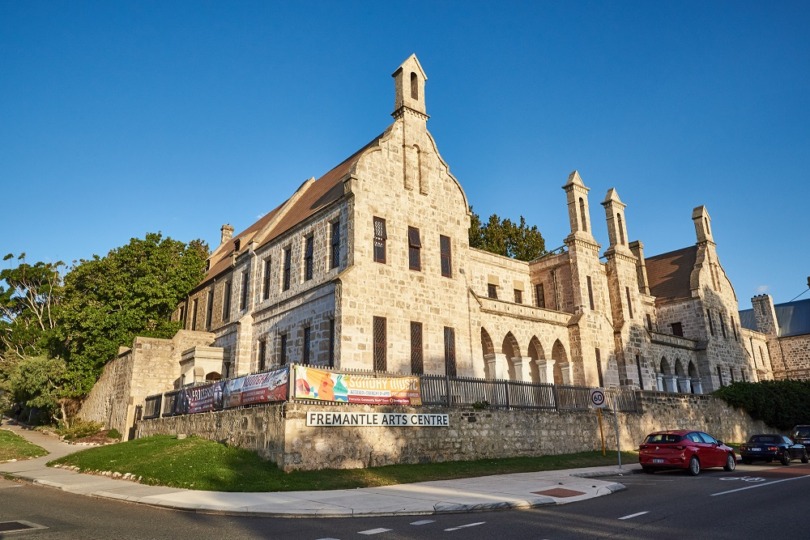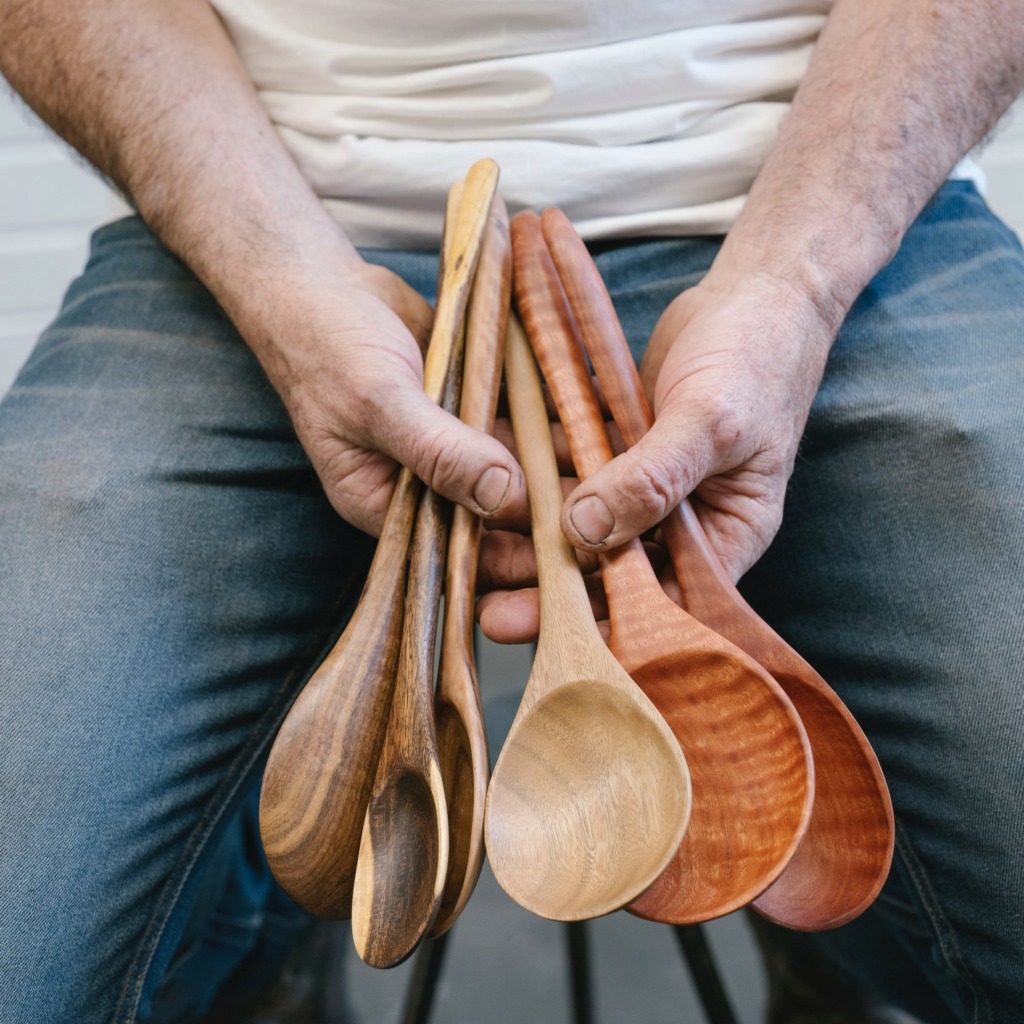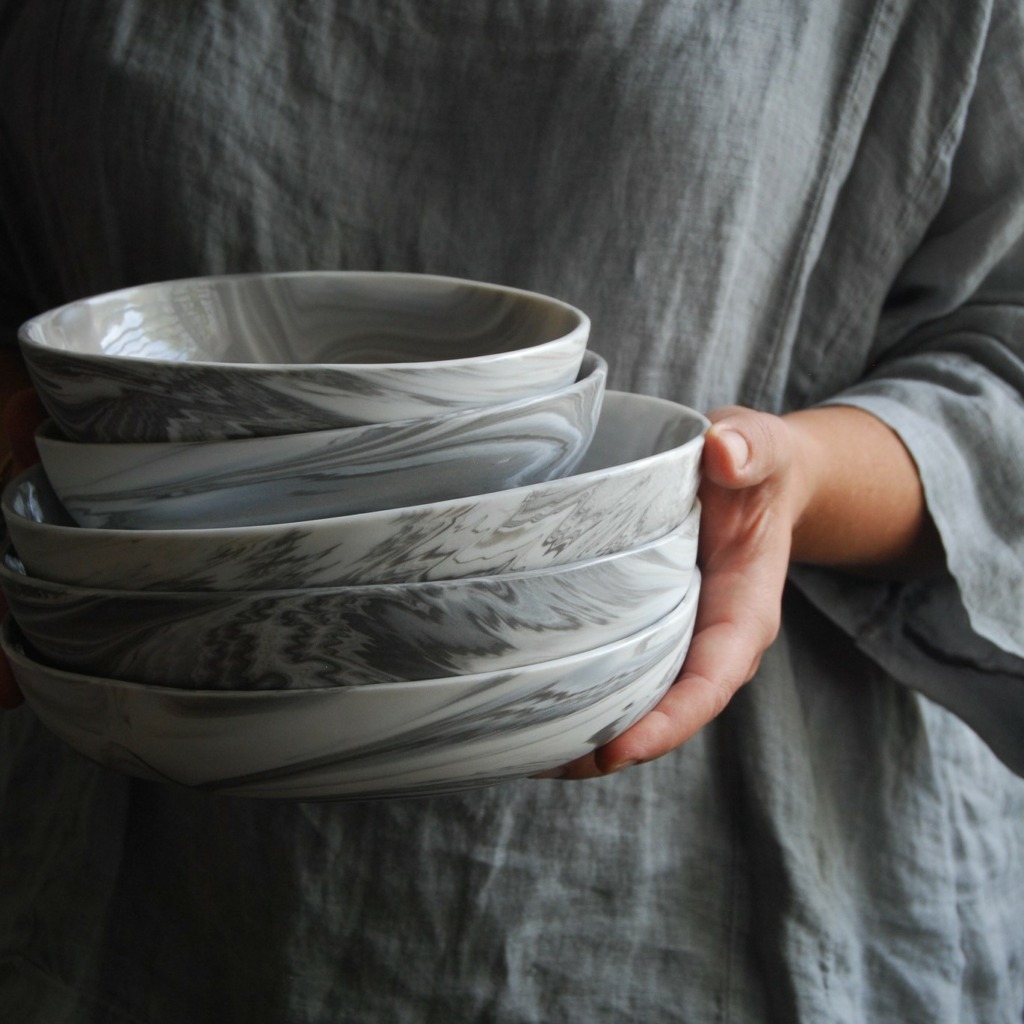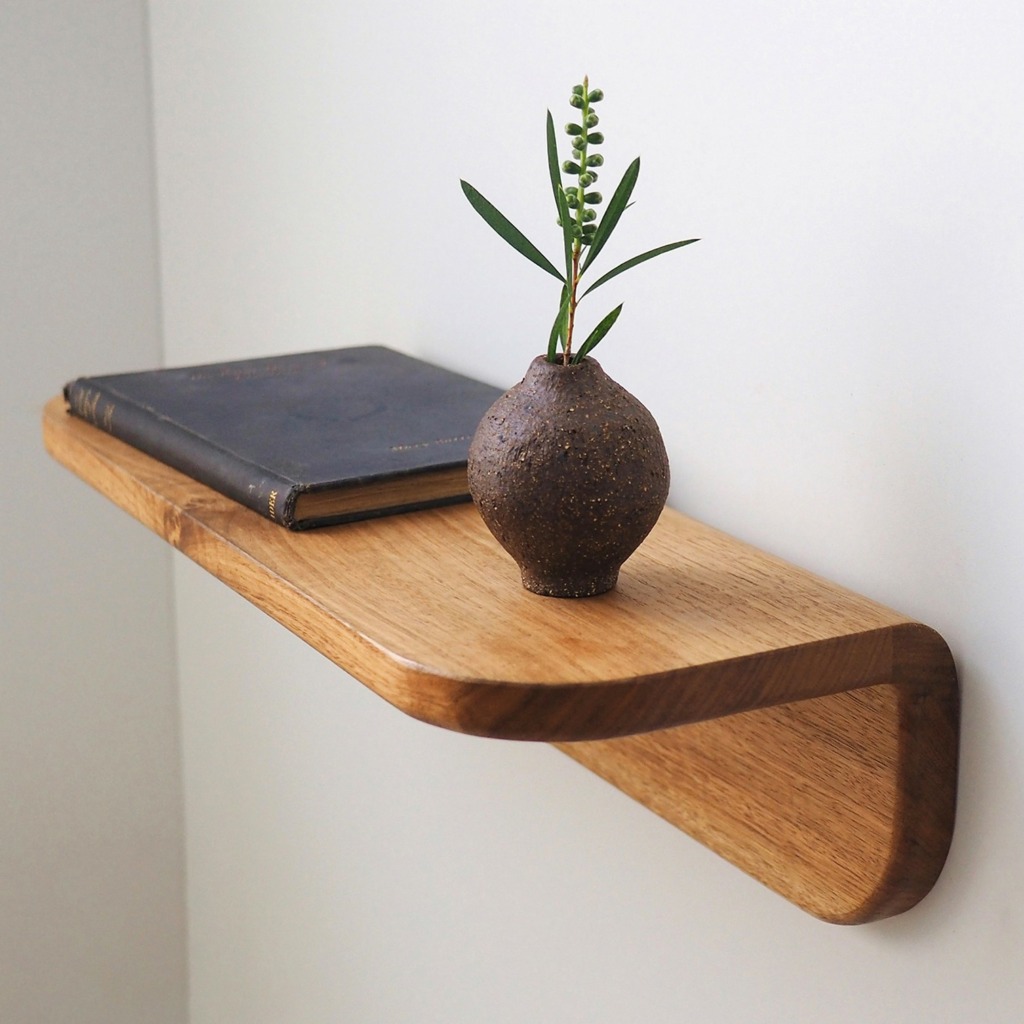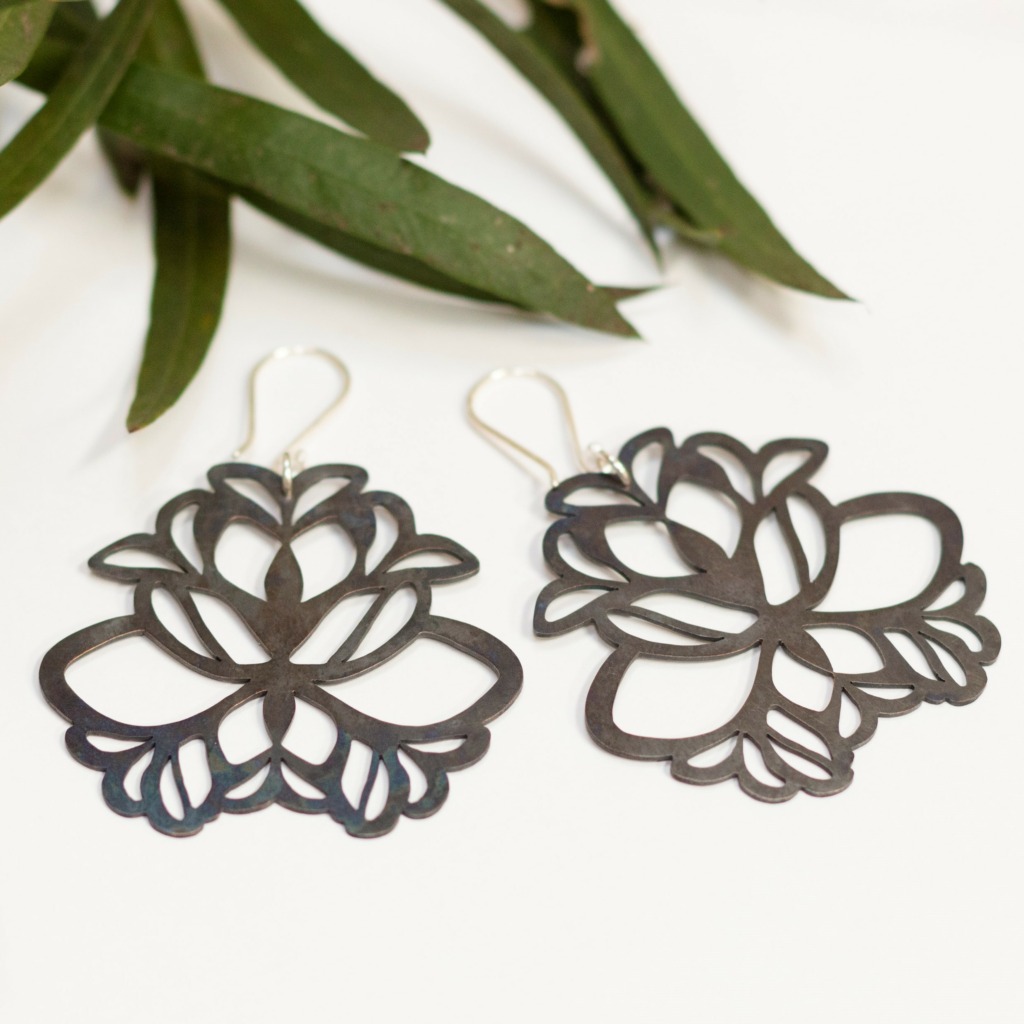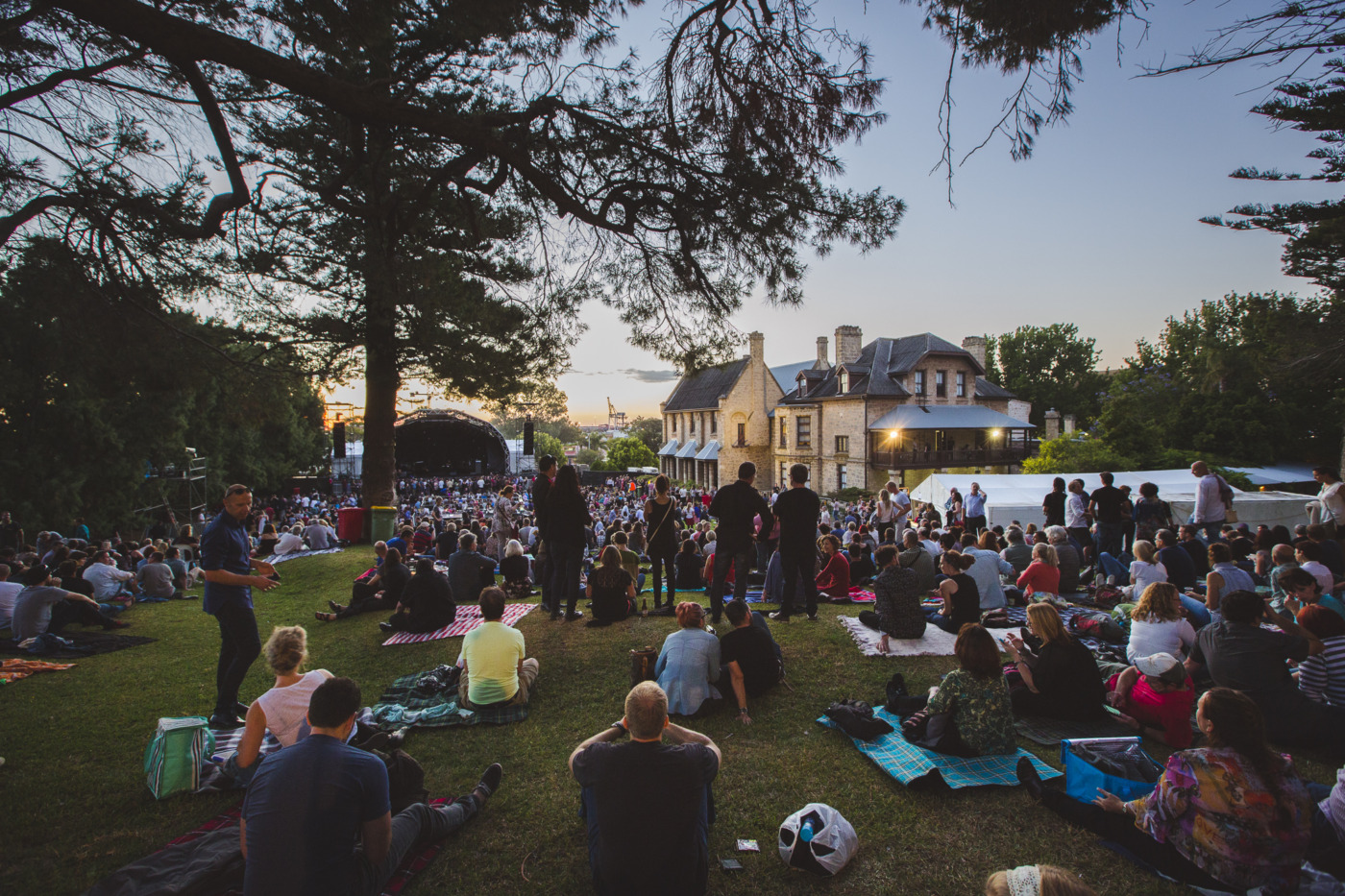Six Western Australian artists have been selected as the inaugural participants in Fremantle Arts Centre’s Groundwork program, a unique new career-bolstering initiative which supports artists to develop their career pathways and realise bold new work.
The six selected artists – Jack Ball, Rachael Dease, Yabini Kickett, Adelina Larsson, Bennett Miller and Taonga Sendama – will enjoy access to a Fremantle Arts Centre studio space and receive a weekly wage for three months while participating in the intensive, artist-led creative incubator.
This model allows each participant to receive meaningful, targeted support in areas they feel it will most benefit their practice and development. Selected from almost 200 applicants, Fremantle Arts Centre Director Anna Reece said the overwhelming response to Groundwork demonstrated the significant gap in the WA sector the program seeks to address.
“We received just under 200 applications to Groundwork from the most extraordinary and diverse group of artists. Every application voiced such a critical need for time, space and financial support for artists. It is important to acknowledge this and continue to advocate for greater resources and opportunities for artists and we are grateful to the Australia Council for the Arts for enabling this initiative to take place,” Fremantle Arts Centre Director Anna Reece commented.
“It was an incredible privilege for the panel to view each and every application and we found it enormously difficult to make our final decision. The six successful applicants articulated clearly what the qualities of the program on offer would contribute to their practice and the outcome it would enable. They demonstrated a generosity and flexibility, an openness and desire to working with others and a reflective practice. We look forward to welcoming this dynamic group of individuals to Walyalup and Fremantle Arts Centre.”
The artists will be in residence at Fremantle Arts Centre from September – November 2022.
Selected Artists
Jack Ball
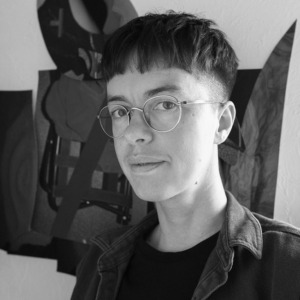
Jack Ball lives in Boorloo/Perth and works with sculptural and collage processes to create photographic images, which are often bodily, performative, intimate and saturated with colour.
In 2021 they had a major solo exhibition at the Art Gallery of Western Australia titled Wind Chill that brought together images spanning 10 years of their practice, including works held in the State Art Collection. In 2021 they also had a solo exhibition with sweet pea gallery and had work featured in group exhibitions the pleasurable, the illegible, the multiple, the mundane (Artspace Sydney, curated by Talia Linz) and Love in Bright Landscapes (PICA, curated by Annika Kristensen).
For Groundwork, Jack will undertake archival research into trans magazine histories, which will inform new large-scale photographic and sculptural installation work. Through collage and abstraction, their work will explore themes of anonymity, pleasure, intimacy, and critically engage with narratives that shape trans lives.
Rachael Dease
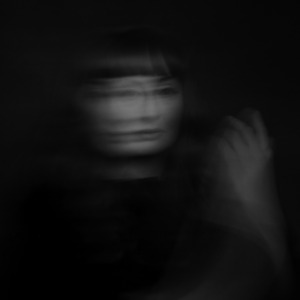
Rachael Dease’s artistic practice encompasses art music, dance and theatre scoring, installation and songwriting. Graduating from the Western Australian Academy of Performing Arts, she won the inaugural Martin Sims Award at Fringe World, the Melbourne Fringe Music Award and received critical acclaim at New York Fringe Festival for her contemporary song cycle City of Shadows.
Her composition and sound design for theatre include the Helpmann Award nominated It’s Dark Outside (The Last Great Hunt), City of Gold (Sydney Theatre Company /BSSTC), The Bleeding Tree (Blue Room Theatre) and Mary Stuart (Perth Festival). Installation includes Vespers (Fremantle Biennale), Black Mass (PICA) Winter Feast 2018-2022 (Dark Mofo), Museum of Water (Perth Festival), and Like Embracing Ice (Fremantle Arts Centre).
In 2020 Dease was Prelude Composer in Residence at Gallop House, Western Australia where she wrote her first solo album Hymns for End Times which was performed with the West Australian Symphony Orchestra in February 2021 for Perth Festival. Dease has recently returned from Sweden, fulfilling a two-year collaboration with Maxine Doyle and Es Devlin on Here Not Here for Gothenburg Opera Dance Company.
For Groundwork, Rachael will incubate a new large-scale sound work, dedicating time to creative and technical research.
Yabini Kickett
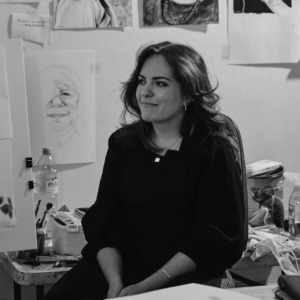
Yabini Kickett (Esther McDowell) is a descendant of the Kickett and Hayden families of the Bibulmun/Noongar Nation. Having grown up with an artist and poet mother, as well as a photographer and land conservationist father, her practice is heavily rooted in language,
endemic plants, family, totemic relations and found objects from country.
In the past four years while working with Noongar Youth part time, Yabini has focused on mediums including textiles, eco dye, found object as well as film and digital photography. Her work comes back to place and orienting herself within disturbed ground.
In 2021 her work I want to go home but they killed her (2020) and Kalaak dress (2019) were acquired by the Art Gallery of Western Australia as part of their COVID-19 Stimulus program. Since then, she’s been exploring curation and portraiture, predominantly working in oil and chalk pastels.
For Groundwork, Yabini will explore portraiture and more abstract illustration on a much larger scale.
Adelina Larsson
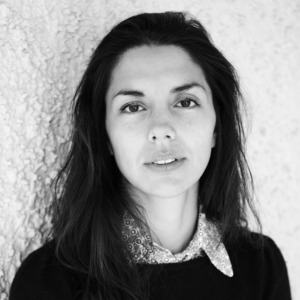
Adelina is an award-winning Swedish/Mexican choreographer, curator, producer, and educator. She works and lives on the land of the Wadandi people – the traditional custodians of Wooditjup/Margaret River, WA.
She trained at Stockholm University of the Arts, DOCH and CODARTS, Rotterdam. Since moving to Australia in 2007 she has worked in remote and regional communities and choreographed for performing arts companies presenting at Melbourne International Arts Festival, Federation Square, The State Theatre Centre of WA, Australian Institute of Sport, The Canberra Theatre Centre, PICA, The Lock Up, and Fremantle Arts Centre.
During Groundwork, Adelina will develop the installation and audience-centred part of her project Min folkdans / ihtotia mahcehua (My Folk dance). The work explores themes of identity, politics, and nostalgia through the histories of Adelina’s dual cultural heritage.
Bennett Miller
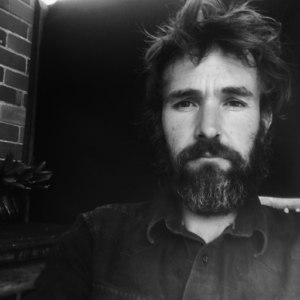
Bennett works across sculpture, installation, video and performance. He has a background producing works for the gallery, but increasingly also develops ‘living sculptures’ for festivals and outdoor contexts.
Since 2010 Miller’s Dachshund UN has been presented in Melbourne, Sydney, Perth, Birmingham (UK), Toronto and Montreal (CAN). In 2012 Miller was included in New12 at ACCA, Melbourne and was a resident at Australia Council’s Greene St Studio in New York. From 2013-2016 Miller presented four consecutive iterations of his fake Amish community at Splendour in the Grass Festival in NSW.
In 2019 Miller presented Behavioural Ecologies (Red) as part of the Fremantle Biennale and he is currently undertaking a residency in Mt Barker for the Spaced 4: Rural Utopias program. For Groundwork, Bennett will develop a new series of performances and associated sculptures within FAC’s grounds.
Taonga Sendama
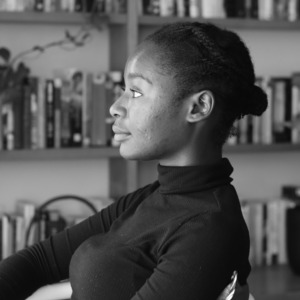
Taonga is a poet, multimedia storyteller and workshop coordinator. Currently her primary focus is community, specifically creating space for other BIPOC artists to share their work. As a Black femme, her work is determinedly and fiercely vulnerable, focusing
predominantly on grief, nostalgia, rest and other small revolutions of the heart.
After her debut at the Western Australian Youth Slam in 2017, she has since featured at the Perth Poetry Festival, National Young Writers’ Festival, and facilitated workshops for Curtin University. In 2021 she was granted the Tina Kane Emerging Writer Award during the Mildura Writers Festival and in 2022 she participated in the Centre for Stories Hot Desk Fellowship.
For Groundwork, Taonga will explore her multimedia project June Rain and allow herself to explore new avenues as an emerging artist. The process will be documented through film photography, poetry, and audio-visual notes.
For interviews or further information please contact Media Officer Rosamund Brennan via [email protected] or +61 (8) 9432 9565
Photography by Jessica Wyld
A recent Artist-In-Residence at Fremantle Arts Centre, Jacky Cheng is an artist and an art educator based in Broome, Western Australia. A finalist in the 2022 Blake Prize and the John Stringer Prize, her work is an exploration of identity through cultural activities and memories of home; country and relationships. We recently caught up with Jacky Cheng to find out more about her practice and the body of work that caught the attention of one of Australia’s longest-standing and most prestigious prizes.
Jacky Cheng
Website: https://jackycheng.com.au/
Instagram: @jackychengart

Portrait of artist Jacky Cheng. Photography by Brett Canet-Gibson
Jacky, you’ve just finished up a residency at FAC. What have you been working on?
I’ve been on a methodology journey. I am currently fixated on making paper threads (kami-ito) from the kozo papers (kigami) I made during a residency in Awagami Factory in Japan back in 2019. Both the papermaking and paper thread making is extremely laborious but at the same time incredibly powerful to have this knowledge. My approach to the residency thus far is about researching, exploring and testing the methodology with the papers I made and various other papers either found or commercially manufactured and at the same time, interrogating my temperament. Due to its lengthy process, it requires the patience of a saint, and there is that constant conversation in my head about the future impact and sad loss of not having these techniques or skill shown or talked about in our contemporary society. It is an impending fear that our future generation may only continue to read this in the past tense rather than a celebrated technique in our contemporary art practice. So, I’ve dedicated my time at FAC to the a strict diet of discipline and a ritual of consistency and rigour – turning up everyday – cut, roll, spin . I am such a studio creature. Being in a dedicated space with uninterrupted time feeds clarity. I look forward to work everyday.
This is not your first time as a resident at FAC. What keeps you coming back?
One of the best aspect of residencies are the non-prescriptive expectations from practitioners. FAC is unique and incredibly diverse in the workforce – everyone is either a practicing artist or works in a creative industry in one way or another. Everyone is super friendly, incredibly helpful and supportive, skillful, knowledgeable, communicative and champions each other. There are always people on the ground ready to assist with your queries. It is the people that makes the place great. I recently read somewhere where FAC is termed as the creative campus. I think it is absolutely apropos to Walyalup and to the surrounding artistic community.

Jacky Cheng working in her studio at FAC
I understand wanted to be an architect in Malaysia until a life-changing holiday in the Kimberley led you to the arts. Can you tell us a bit about that?
I grew up in the city (M’sia) and then moved to another city (Sydney) for my tertiary education. I was sold the impression to be successful is to be a professional in the city. The ease of navigating myself in a cityscape is convenient and familiar. My move to the Kimberley stemmed from my first encounter with a Broome local in a local cafe where she told me about her background and multiracial identity. It dawned on me that I knew nothing about Australia and First Nations people. My first trip to a remote indigenous community was a memorable one. I was sent out there to teach as a TAFE arts lecturer. Long story short, it took me a while to realise that story-telling is a way of making sense of someone or where they come from. They loved listening to my experiences as a Malaysian Chinese immigrant in the Kimberley and I love listening and learning about their ancestral connections to land, sea and sky. There is a plethora of similarities in our exchange which includes the non-verbal deliveries, such as the nuances of sitting together quietly. There is that beautiful calm in story-telling until one of us starts cackling and infects the rest of the group. It felt like home to me.
Your work often explores the duality of being a Malaysian expatriate in Australia, while also being ensconced in the First Nations culture and spirituality of Broome, where you live. What is it about this you find so interesting?
In Malaysia (and possibly in the neighbouring country, Singapore), the term Banana Girl is very common and often associated with people of Chinese descendent who aren’t able to read, write or speak Chinese. My mum refers me a Banana Girl. When I was younger, following the Western culture was pretty cool and current because that was the only ‘outside’ influence we were exposed to via television. I attended public school where Bahasa Malaysia was the predominant written and spoken language in our school work except English lessons. Outside of school and or at home, I would speak in a mix of Cantonese, Mandarin, English or Bahasa and sometimes both my grandmother’s dialects Hainanese and Teochew. But I am neither fluent nor excellent in any of my ancestral native languages. My first public shaming experience was when I was travelling in Hong Kong, proudly showing off my spoken Cantonese to my travel buddies as if I’ve got their back only to realise that I was shamed by a local resident of my ‘defect’ when I fail to read his writing when I’ve just spoken to him in Chinese. It is a literal sense of feeling in-between and being Chinese but not Chinese enough. But the more visceral way of experiencing this is the fact I felt the invalidity of my sense of belonging.
- Jacky Cheng, Honour and Love
- Jacky Cheng, Xiang Lu III – Incense Cencer
When I arrived in Broome, I experienced the similar ‘multiplicity’ from the community. When I finally found some common stories or similarities of my native home identity in Broome, WA, I realised I never really left ‘home’ but more so embrace a slightly different narrative of ‘belonging’. My practice touched on personal experiences and at the same time taking the liberty to investigate the notion of ‘place and identity’ or what Broome or Kimberley means to me. Living and practicing in Broome is special. The motivation is different – it is respectful and sensitive story telling. Culture comes from place. Everyone has such a rich and diverse story with strong family connections. It continues to baffle me by how much more I do not know even after 16 years of living in the Kimberley. I channel that interdependence in my art practice. It embodies my practice with intent and with purpose.
Congratulations on being named a finalist in both the Blake Prize and the John Stringer Prize. How does it feel to be recognised in these prestigious awards?
One of my good friends told me about the Blake Prize after a brief conversation about the piece that I’ve been working on. I looked it up and saw the previous finalists names and thought to myself that I am no where at the level of these established artists with such rigour in their practice. Nevertheless, I thought I should give it a go. I’ve had plenty of rejection emails and unsuccessful selections in the past. It definitely helps define the work I do. I remember telling my partner and another friend the morning I received the congratulatory finalists news for the 67th Blake Prize. They congratulated me (but of course they had no idea what The Blake Prize is about…). I found myself skipping and smiling from ear to ear and crying at the same time. I am over the moon to be a finalist. That’s a win to me. As a regional artist, sometimes the distance hinders you from many great networking opportunities but of course with the accessibility of various online platform means that you are a tad closer… just a tad closer.
My Blake Prize submission is titled Yue Lao – The god of Matchmaking and Marriage, and it explores my late uncle’s marriage which was arranged by my Grandma, Ah Ma. Yue Lao is an old learned Chinese mythological cupid. He is believed to be immortal, and his focus is finding the perfect marriage matches for people. The work is made from sheets of recycled Chinese calendar papers that I religiously tear every day. In this in-between homeland – Australia, I struggle to clarify tales and myths with my elders. But there is a desire to understand why some practices still exist today but just in a different structure.
Jacky Cheng, Yue Lao – The god of Matchmaking and Marriage, 2022
The John Stringer Prize finalist announcement is another skip, ear to ear smile and cry moment too. I am in the process of making this piece and the work will be exhibited at the prestigious contemporary John Curtin Gallery in October this year. I am super chuffed with this opportunity and to be alongside my other finalist peers.
I understand your interest in paper and ‘slow art’ stems back to your relationship with your Grandmother. What kind of rituals did you practice together and how did these inform your practice?
The act of doing and making was already part of my upbringing. Folding thousands of joss papers in one sitting was not recognised as an artform at home but only as mandatory duty for girls/women. I most certainly was not allowed to pursue art as a career. So, I found the next best and most glamorous job in the dictionary and thought being an architect will somehow bring me closer to art. But of course, my intention was tested and the thought of me, a female, not carrying the family name after marriage is not worth the family’s investment. Long story short, I broke past that with my brother’s guidance in convincing my family that I am worth the investment in gaining a respectable qualification to aid my future endeavors. Then I rebelled. I jumped ship. I pondered this thought about my role as a female, home maker and how my name is less important than my brothers for a long time.
The thought process shifted when I was able to articulate the rituals we performed at home to my brother who has absolutely no clue. I found myself revisiting the process from the time I spent with my grandmother. There were ways of doing things that makes so much more sense now to me as an adult than when I was a child. The rituals, the making, the ephemeral beautiful folded paper works we prepare only to be burned away in the fire as an offering to the deities or ancestors. Bringing all these evocative sentiments into the studio, into my practice, enriched my role as a practitioner, a woman, homemaker, daughter, sister and more importantly a carrier of the ritualistic significance in my practice. My grandmother performed her role her entire life with very strict guidelines in her society. I will continue to perform my role in telling the stories and be the in-between of what ‘was’ and what ‘will I do’ to the next generation but maintaining the integrity of culture and its significance in the Taoist tradition. Paper is like my second skin. I’ve worked with paper since I was a child and there is so much more to learn about it in this lifetime. Perhaps that’s the narrative of ’slow’ I am referring to.
Jacky Cheng’s work is on display at the The 67th Blake Prize Exhibition – Casula Powerhouse Arts Centre till 22 May.
Fremantle Arts Centre has been awarded a $100,000 grant from the Australia Council for the Arts to implement Groundwork, a new initiative which will bolster the careers of Western Australian artists, supporting them to develop new career pathways for the realisation of bold new work.
Groundwork will provide six practitioners with a studio space and a weekly wage while they participate in an intensive, three-month creative incubator designed to support the creation of new work, develop their arts business acumen and engage in critical response and review.
Facilitated by FAC and its partner organisations, Groundwork will provide access to a range of meaningful resources and support, including structured professional development, networking with senior artists and arts managers, access to studio space, support with installation, production and presentation of works as well as cross-industry collaboration.
According to Fremantle Arts Centre Director Anna Reece, “Groundwork has been developed in response to the significant gap within the Western Australian arts sector for structured outcome-based capacity building for artists across disciplines.”
“As a creative campus committed to fostering a community of innovation and collaboration, Groundwork harnesses FAC’s existing activities to offer a cohesive and accessible program that maximises opportunity and impact – empowering practitioners and providing them, with the resources they require to embrace risk and engage in rigor in their practice.”
“We are truly grateful to the Australia Council for the Arts for this grant enabling us to appropriately and strategically support our cultural ecology.”
While Groundwork is an outcome-based program, it is entirely artist-led, enabling each artist to self-determine the outcome they seek and address the most pressing needs of their practice.
Among the comprehensive range of support, resources and collaborations on offer, artists will have the chance to partake in a series of specially curated think tanks, featuring local and national provocateurs immersed in a conversation about culture, politics, technology and the environment through the lens of artistic practice. Recognising the importance of generating writing and scholarship around practice, FAC will also support one piece of long form writing in response to or around each artists’ practice and their work.
In keeping with FAC’s commitment to truth-telling and place-based narrative, Groundworks artists are provided with access to custodians of Nyoongar culture to inform their practice and ground their projects to the Country on which they are made, Whadjuk Nyoongar Boodjar.
Groundworks is open to all practicing emerging and midcareer artists working in a range of artistic disciplines with applications opening on Monday 4 April. The six selected artists will take part in the inaugural program from September to November 2022.
For full application details please see the Groundwork page.
For interviews or further information please contact Media Officer Rosamund Brennan via [email protected] or 0434 936 355.
Photography by Jessica Wyld.
As an island continent flanked by deep waters, the ocean holds a firm place in the Australian psyche as a symbol of freedom, pleasure and awe. But a deeper look by a group of Australian artists reveals our oceanic ties are far more complex than first meets the eye.
Presented in association with Perth Festival, Undertow charts the social and cultural histories of our oceans, exploring their role as places of arrival and departure, pathways to freedom, economic highways, sites of colonial terror and vessels of deep ancestral knowledge.
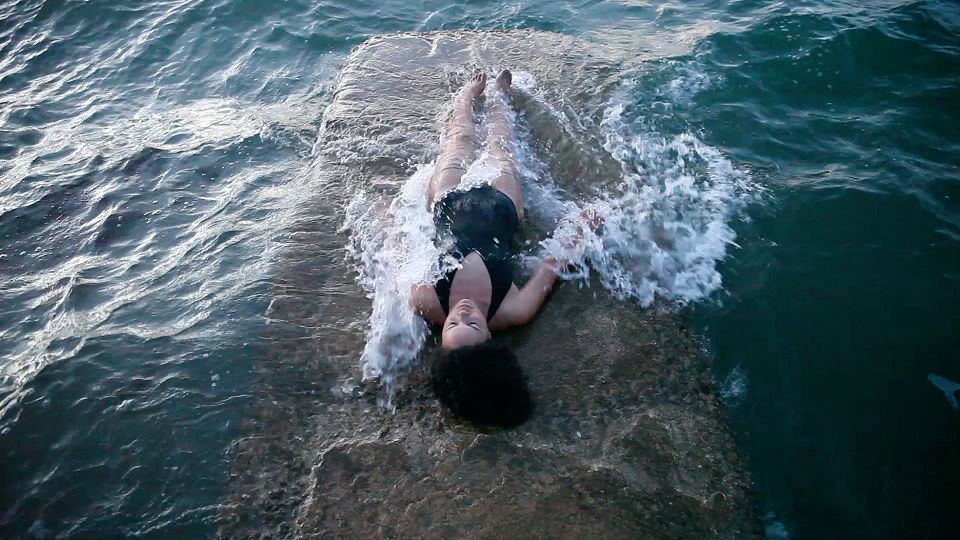
Angela Tiatia, Holding On (detail), 2015, single-channel high definition, video, 16:9, colour, sound, 12:11 minutes, dimensions variable. Courtesy the artist and Sullivan+Strumpf, Sydney | Singapore © Angela Tiatia. Image courtesy: Queensland Art Gallery | Gallery of Modern Art, Brisbane.
Glenn Iseger-Pilkington, Fremantle Arts Centre’s Curator Visual Arts, commented, “Undertow is about what sits below, what can’t always be seen, but is always felt. It is about going against the current, about deep reflection upon our worlds and lives and more than anything, it is about not resting comfortably in any truth which is not our own.”
Corresponding with Perth Festival’s 2022 theme of wardan (ocean), the exhibition brings together eight artists with strong personal and familial ties to Australia’s coastline and the oceans that surround us, including Amanda Bell (Yued & Badimia People, WA), Sam Bloor (WA), Ron Bradfield (Bard People, WA), Elisa-Jane Carmichael (Quandamooka People, QLD), Sonja Carmichael (Quandamooka People, QLD), Garry Sibosado (Bard People, WA), Soul Alphabet (WA) and Angela Tiatia (Samoan/Australian, NSW).
Working across varied mediums, including large format cyanotype, glass neon, installation, photography and film, their works plumb the depths of our relationship to the expansive waters that surround us, bringing to the surface tales of hope, betrayal, and transformation.

Ron Bradfield, Off Caps, 2019, installation of RAN service cap with HMAS Westralia tally band, boomerang and red ochremarked pearl shell (Guwan). Image courtesy the artist.
“From the evocative filmic works of Angela Tiatia to the delicate pearl shell installations of Garry Sibosado, the exhibition submerges audiences into a deep ocean chasm of layered stories, offering reflections on identity and family, alongside more universal concerns of migration, dispossession and the exploitation of natural resources,” Glenn Iseger-Pilkington continued.
Quandamooka mother and daughter Sonja and Elisa-Jane Carmichael will present Dabiyil Bajara, a new commission and their most ambitious installation to date which honours the waterways of Minjerribah (North Stradbroke Island) as an enduring source of healing, sustenance and wonder. Translating to ‘water footprint’, the installation comprises six epic-scaled cyanotypes which will be draped from the gallery ceiling, featuring ancient Quandamooka stories, plants and animals.
Extending upon her recent creative exploration, Badimia and Yued artist Amanda Bell will present a new installation which employs sound, glass neon and sculptural form to approach the theme of wardarn (ocean) through a lens of personal and collective trauma, while Angela Tiatia’s poetic filmic work Holding On offers a poignant and timely reminder of the imminent threat of a changing climate upon Pacific island communities, and low-lying island communities globally.
Over 270 shimmering pieces of pearl shell and crystal comprise Garry Sibosado’s Oongoonorr, his most elegant comment on the contemporary world to date. His personal reflection on the Milky Way, or the ‘ocean in the sky’, Oongoonorr creates a space to reflect on the interconnectivity of all living things, the wonders of the natural world and the insidious speed of corporate development in Western Australia.
The work of artist and storyteller Ron Bradfield explores the confluence of two seemingly opposing salt-water experiences – the first of being a Bard from the Kimberley, and the second of being a member of the Australian Navy. This significant body of work documents the interplay of these worlds and Bradfield’s deep affinity with saltwater Country.
Exhibited both on-site at Fremantle Arts Centre and at Fremantle Esplanade, Sam Bloor’s newly commissioned text-based works offer highly considered text provocations and design treatments, to interrogate Australia’s hard-line stance on border protection at a time when our border has never been so ferociously defended.
Soul Alphabet, an organisation committed to amplifying the voices of People of Colour, will present At the Ridges of Our Hands, a photographic series capturing the hair braiding practices of African diaspora living in Boorloo and Walyalup. Travelling across the seas with the movement of people, this important cultural practice is also an arbiter of connection, belonging and community, as revealed in Soul Alphabet’s intimate portraits.
Perth Festival Visual Arts Program Associate Gemma Weston said: “The genius of bringing together such a varied group of responses to the ocean in Undertow is how, in conversation, they remind us of what we have in common as people. It is hard to think about the vastness of the ocean and not to be reminded that we’re part of something much bigger than ourselves. Undertow will be as beautiful as it is rich – and these artists share an understanding of how beauty can help us to confront some difficult truths.”
Undertow opens 6:30pm Friday 4 February and is then open daily from Saturday 5 February to Monday 25 April 2022. A series of accompanying public programs and events will be announced soon, with full details available at fac.org.au.
Undertow is presented in association with Perth Festival.
Media Contact: Rosamund Brennan, [email protected], 08 9432 9565
Artwork details: Sonja Carmichael and Elisa-Jane Carmichael, Balgagu gara (come celebrate) (detail), 2020, cyanotype on cotton, 278 x 274cm. Image courtesy of the Artists, Onespace Gallery and the Art Gallery of South Australia. Photography by Grant Hancock
With Bazaar 2021 just around the corner, we’ve compiled this handy guide of need-to-know tips and tricks to ensure your day at the market is a successful one. Read on and get excited about WA’s favourite Christmas Makers’ Market, which returns to FAC from 3-5 December.
Download the Safe WA app before you leave home
All visitors to Fremantle Arts Centre must register their contact details.
Download the SafeWA app before you leave home for the quickest entry. Then you’ll simply need to scan FAC’s QR code, available at the entrance, before you enter our grounds.
If you prefer not to use the app, speak to our gate staff to register your information.
Your contact details will be encrypted and stored for 28 days by the WA Health Department. They will only be used if COVID-19 contact tracing is required.
Download the SafeWA app in the Apple App Store or Google Play.
Card payments A-Okay!
For the first time in Bazaar Each stallholder, our front gate and all food vendors are fully equipped with card facilities.
Entry is $2 per adult, kids under 12 are free (payable by card or cash).
Cash or EFTPOS payments for products can be processed at reception. Fremantle Arts Centre gift vouchers can also be used at reception.
Parking
Please respect our neighbours and don’t park on the residential streets surrounding FAC. Limited free street parking is available on Finnerty, Ord and Vale Streets. Parking is also available at John Curtin College of the Arts and Fremantle Leisure Centre for a small fee.
Alternatively, take public transport. FAC is a short 10-minute walk from Fremantle train station with several bus routes stopping nearby. Head to the Transperth Journey Planner to find your best route.
BYO shopping bag
While some stallholders have bags available upon purchase, it’s a good idea to bring along your own shopping bag to ensure you get all your goodies home safe and sound.
Grab a Map
Pick up a map at the gate to help you easily find specific stallholders, toilets, bar, food vendors and change rooms.
Gift Wrapping Available
Want your gifts beautifully wrapped? We can help! Gift wrapping is available by donation – head to our station in the Inner Courtyard.
Search #FACBazaar on Instagram
Search the #FACBazaar hashtag for a sneak peek at all the amazing products you can expect to find at Bazaar and to follow stallholders you love.
We’d also love you to share your Bazaar experience with us. If you take any pics over the weekend be sure to tag us @fremantleartscentre and #FACBazaar.
Meet the makers
There’s nothing better than buying direct from makers and artisans. Take the time to chat with the people who have made the things you’re coveting. They’d love to tell you more about their range and how their products are made.
Food & Drink Offerings
There will be lots of yummy food to choose from to keep your energy up while you shop. Head to the food court area at the rear of the building to find a selection of delicious meals from an array of food vendors and a fully stocked bar (open from 5pm on Friday and 12pm Sat + Sun).
This year’s food vendors include: Tommy Taco, FareGo Food Truck, Pak Catering, Banh Mi (Traditional Vietnamese Food), Canvas Café, and Canvas Stall serving coffee and muffins, Big Loaf and La Paleta.
We will also have a water station, so bring your refillable water bottle.
Workshops & Activities
There will be a kids’ activities area located on the top tier lawn, offering Christmas bauble decoration workshops as well as advent calendar colouring in sheets designed by local artists Anthea Carboni and Flora Waycott in the Kids’ Activities Area up on the Top Tier. These run from 10am – 4pm on Saturday and Sunday.
Adults can get in on the making too, learning to create their very own block printed tea towel with multi-disciplinary artist and popular FAC tutor Bori Benko. She’ll guide you through the process of designing, carving and printing onto fabric in this ninety-minute workshop. There are eight sessions available across Saturday and Sunday. More info and bookings available via www.fac.org.au/courses/adults/
Entertainment
Browsing the stalls will be made even more fun with the addition of live music throughout the weekend, including a roving Mariachi band and brass band, as well as a fun Christmas playlist curated by DJ Rok Riley.
Be sure to pop in and check out Hundreds & Thousands: An Immersive Kids’ Colour Adventure – a vibrant exhibition taking kids and families on a journey through colour and art.
Change Rooms
Change rooms are located on the croquet lawn next to the water fountain near stall 37.
Leave your dog at home
We love dogs but they’re not permitted within FAC grounds.
Treat yourself!
Go on, you deserve it.
Joining us as a stallholder at Bazaar 2021, Ronel Koen is a ceramic artist and the creative brains behind the Swalō Ceramics brand located in the heart of Fremantle. Her practice is inspired by Nerikomi, a decorative process established in Japan that involves stacking colored clay and then slicing through the cross section to reveal a pattern, which can then be used as an applied decoration. Creating a range of unique and one-off ceramic pieces, including ring flower bud vases, bowls and vessels, Ronel is part of our inaugural Bazaar Incubator, a mentorship program for emerging makers in the first five years of their practice or who have never been a part of Bazaar.
Could you please tell me about your ceramic practice and the techniques you are most drawn to?
Most of my work is inspired by and explores the principles of Japanese Nerikomi techniques. In Nerikomi, slabs of clay are layered, folded, and pressed, over and over until it creates a beautiful design or pattern. I am exploring creating very precise designs and patterns through the controlled layering and placing of colour-stained clay and then inlaying these designs into wheel thrown vessels. This inlaying process creates pressures, distortion and introduce movement into the pattern making every piece I create completely unique and visually dynamic.
Other than my exploration of Nerikomi, my practice is a study of the intricate relationships between aesthetics, form and function and my work aims to bridge the divide between function and art. Each piece is carefully conceptualised and created around a core narrative where each form follows this narrative. My work aims to return art, and the art experience, to everyday living.
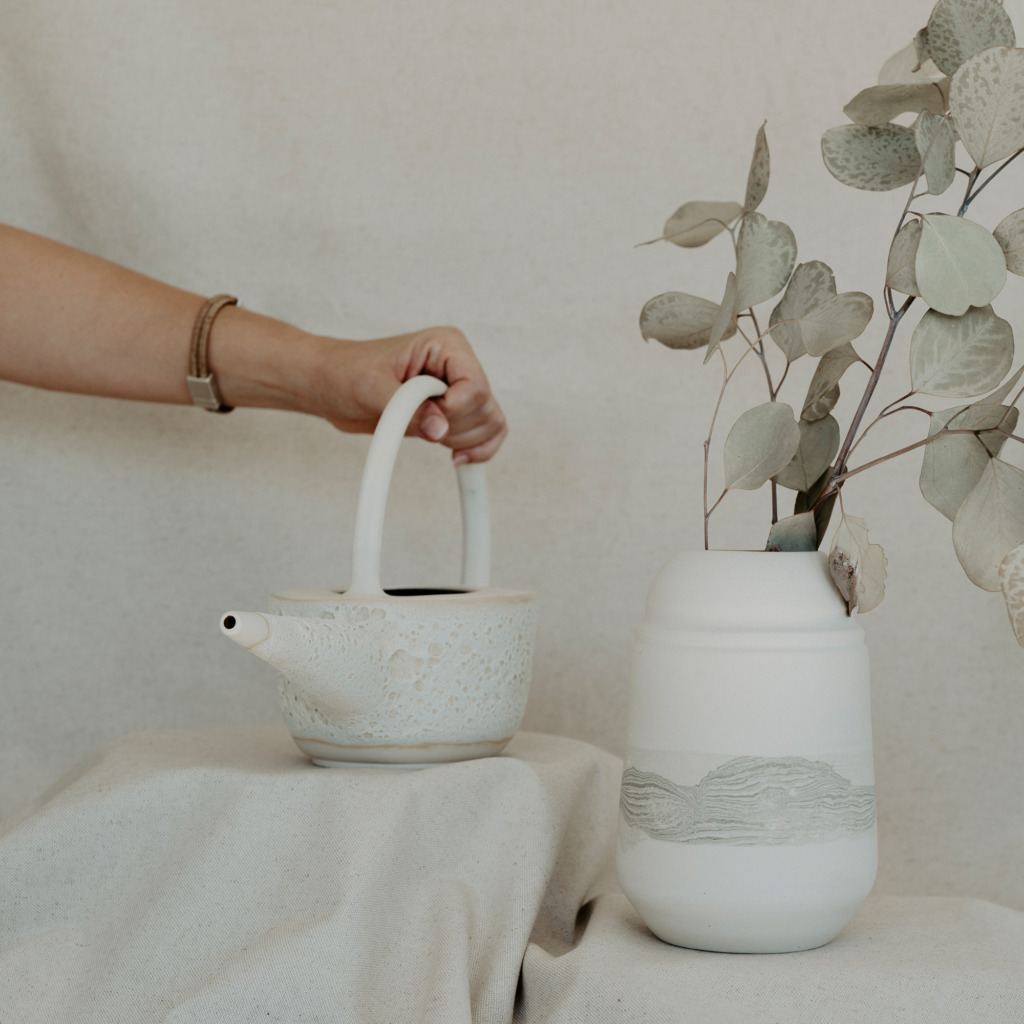
Hummingbird Water Can & Vase
How long have you been making ceramic work and what is it about this particular art form that you love?
My intense and lingering love affair with clay started over 27 years ago as a young fine and applied arts student in South Africa. But as life often does, mine turned and wound into other directions, and for the past 20 years I’ve been building a creative career as a designer and art director, both in Australia and abroad. It’s a journey that’s been fabulously rewarding, but as with all great loves, that yearning for clay stayed with me and kept drawing me back.
I missed the physical rawness of the artistic process, the hands-on making, and the fact that clay forced me to slow down. How it just so shamelessly and unapologetically commands my attention. Ceramics feels relatable. It’s a tactile, primitive medium, where you can create strikingly beautiful work, that actually has a practical purpose. I see working with ceramics as an opportunity to push the boundaries of how we perceive art, and create pieces that cross the divide between art, and object.
What kind of products can people expect to see at your stall at Bazaar?
I will be presenting a beautifully curated range of functional and decorative handcrafted ceramics. From high end, one-off Nerikomi designs, a range of unique ring flower bud vases, bowls and vessels, watering cans, incense burner to quirky little stocking fillers. There will be something unique for everyone and every price range.
You are part of our inaugural Bazaar Incubator, a program which mentors makers within the first five years of their practice. What has that experience been like?
It has been an incredible opportunity to be included in such a well-respected, iconic and coveted event that most small business like mine would otherwise not have access to. It will be a very important springboard for my young fledgling business which will help to introducing and connect products with my local community and market and increase awareness of my brand. The FAC has been amazing in offering support and reassurance and making me feel confident in gearing up my production and work for the Bazaar. I am so grateful for this wonderful opportunity.
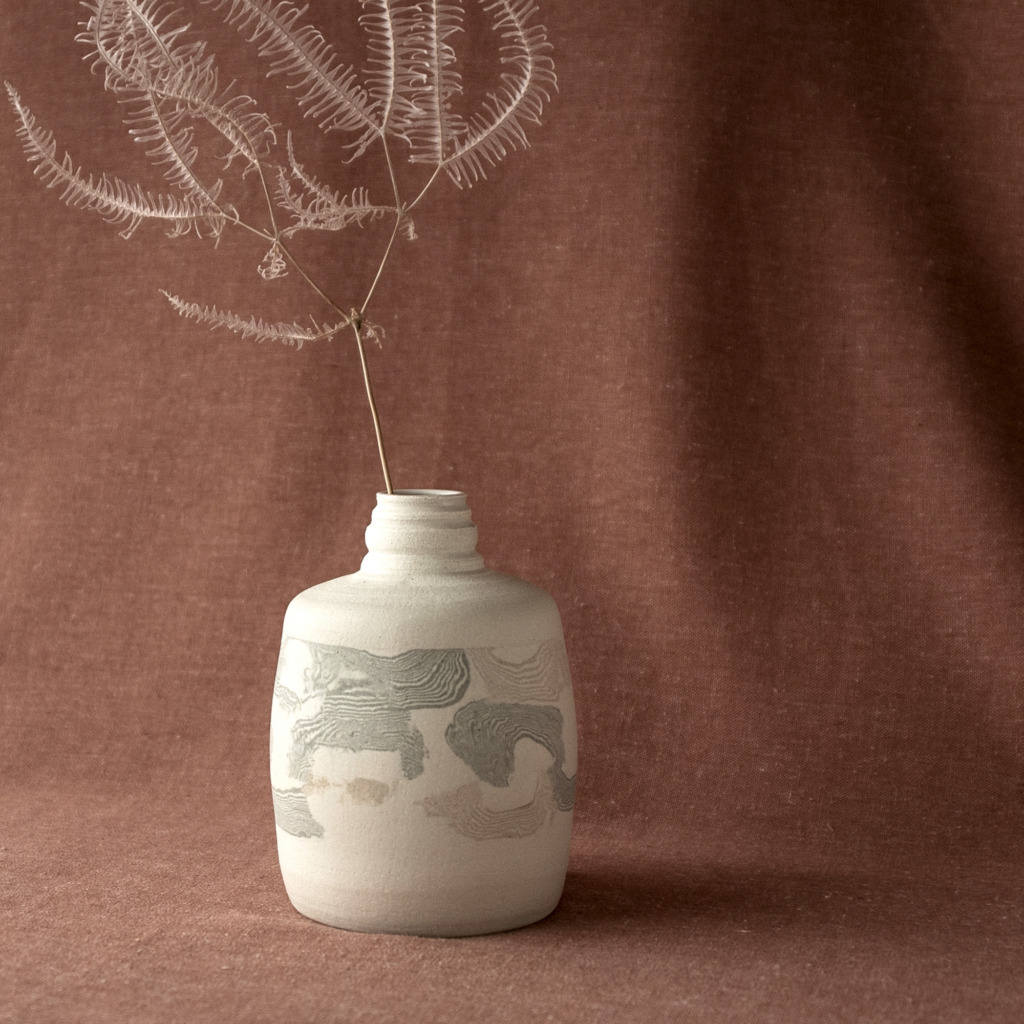
Nerikomi Vase
Why do you think people should support local makers and buy handmade Christmas gifts?
First of all, handmade products are great for the environment. Most handmade products do not require large production facilities. Instead, are made locally in small studios or small workshops.
Handmade is always unique, made by a real artist or person, which makes the product and the purchase very special. It gives you access to the maker and artist and nobody in the world will ever have exactly the same item as the one you have purchased. Each handmade item has a unique story behind it and by buying it you become part of the story.
When you buy handmade you directly support a local artist, which in return help in supporting traditional crafts and practices. By supporting these practices, you help pass them on to the next generation keeping the arts and crafts alive. But mostly, buying local shows the person that you are giving to that you care.
Bazaar – WA’s premier Christmas makers’ market – runs from 3-5 Dec at Fremantle Arts Centre.
From 3–5 December, Fremantle Arts Centre’s Bazaar – WA’s favourite Christmas makers’ market – returns to the port city.
This much anticipated annual market brings together more than 50 local designers, artists and craftspeople – offering unique, handmade gifts and homewares including jewellery, textiles, ceramics, woodwork, fashion, prints, stationery, toys and more.
Fremantle Arts Centre Director Anna Reece commented, “Bazaar is a celebration of the handmade, offering our community a rare chance to browse the highest quality gifts from WA artisans all in one place – alongside music, craft workshops, delicious food and plenty of Christmas cheer.”
“It’s an event that embodies Fremantle Arts Centre’s role as a home for makers, a place that fosters creativity and forges connections between artists and the community. Treat yourself or a loved one to an exquisite creation while supporting our local creative industries.”
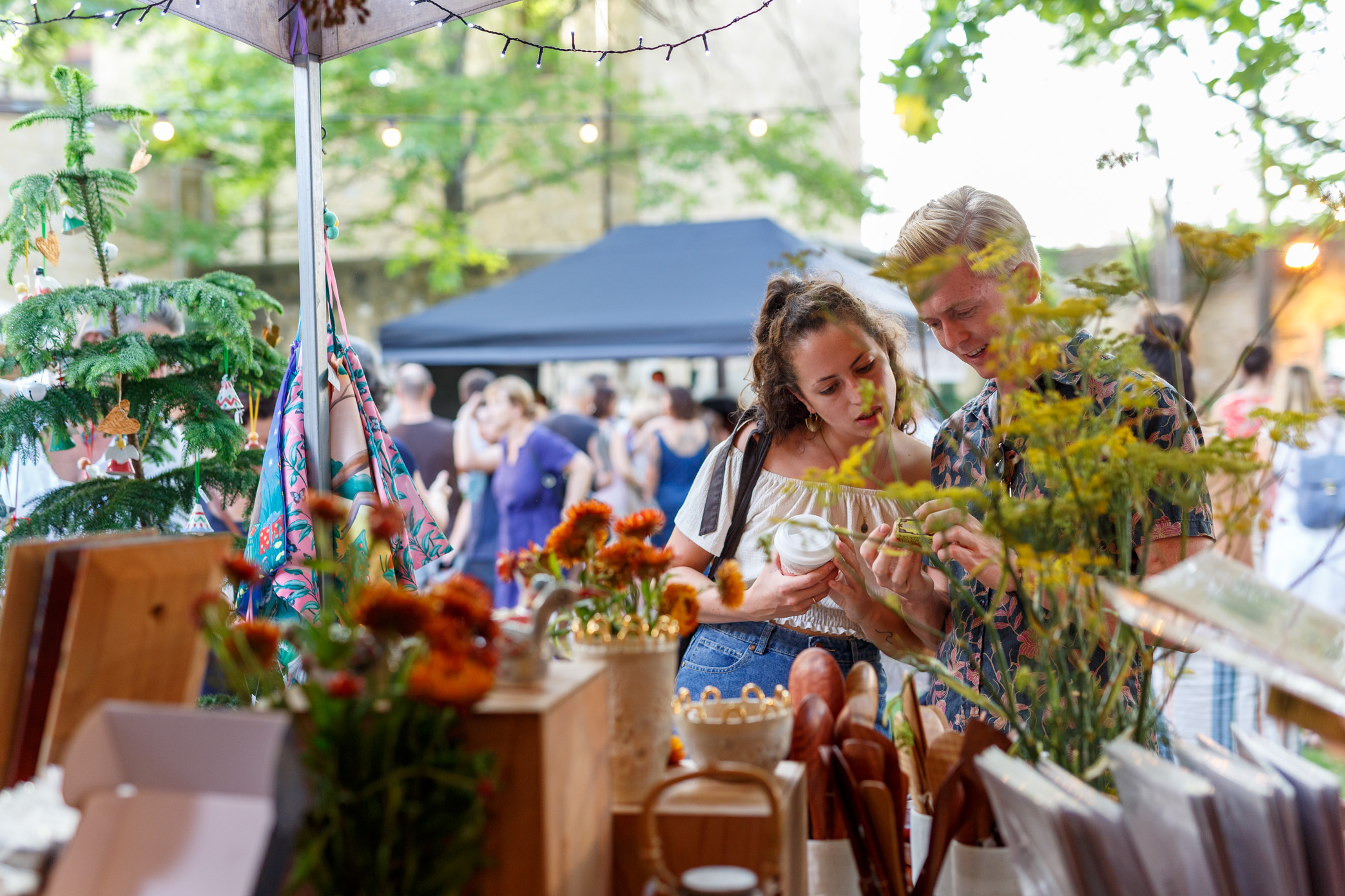
Among the diverse creations on offer at this year’s event, you’ll find recycled timber furniture by wood craftsman Tony Docherty, who has exhibited his works at Tokyo Design Week and Milan’s Salone Satellite, and Deep Earth Ceramics’ collection of vases, keep cups and bowls, lovingly handcrafted in Fremantle.
Also joining the stallholders is self-confessed knitting addict Gloria Toniatti of UFFA Collective, who will present her one of a kind knitted creations and textiles, and Dunsborough based contemporary jeweller Nicola Macklin of NTM Jewellery, showcasing her ‘perfectly imperfect’ silver earrings, rings, necklaces and bangles.
New to this year’s event is the Bazaar Incubator, a mentorship program which provides support and guidance to 5 emerging artists who have never before traded at Bazaar, including homewares designer Kamisaki Studio, textile artist Mamy Hews, Swalo Ceramics, Manner Furniture and Pottery By Shupiwe.
- Tony Docherty
- Ceramics by Danica & Beste
- Turner & Turner
- Jewellery By Susannah & Ilka
Another new addition to this year’s event is a series of craft workshops for kids and adults running throughout the weekend. Kids can enjoy Christmas decoration workshops as well as advent calendar colouring in sheets designed by local artists Anthea Carboni and Flora Waycott. For adults, multi-disciplinary artist Bori Benko will lead a block printing workshop where you can decorate your own linen tea towel.
To keep visitors in the Christmas spirit there’s also a bar and delicious food options all weekend, in the lush surrounds of FAC’s grounds, as well as the occasional surprise pop up performance.
2021 Bazaar Stallholders
Andrea Osses Design
Bedtonic
Belen Berganza
BLACK & DAWSON
Blue Lawn Designs
Braw Paper Co.
Ceramics by Danica & Beste
Claymake Collective
convict
Daniel(ink.)
Deep Earth Ceramics
Dingo Sauce Co
Fleur Schell
FOUND
Golden Whisk
i j e w e l l e r y
Jessica Jubb Jewellery
Jewellers & Metalsmiths Group of WA Inc
Juluwarlu Art Group
Kamisaki Studio
KIN SWIM
Kor by Lisa Gardner
Kristin Magrit
Mamy Hews
Manner
Many Peaks Assembly + Deli Mates
Map Journal
Melting Pot Glass Studio
Nagtzaam
Nagula Jarndu (Saltwater Woman)
Native Needle
Nikked glass
NTM Jewellery
Patong /Alison Bullock
Penelope Brittain Jewellery
PIXEL CAT
Pottery by Shupiwe
Prints By Bow
Robin Wells Jewellery + Eucalypt Homewares
Semblance
SWALŌ Ceramics
Tinctorium
Tony Docherty
Turner + Turner
Two stories
UFFA Collective
Viviana Maier Porcelain Objects
Woven Stories Textiles
You Me Berlin & Susannah Kings-Lynne
Yuniko Studio
Bazaar runs Fri 3 – Sun 5 Dec (5–9pm Fri, 9am–5pm Sat + Sun). $2 entry, free for kids under 12. Bar + food available.
Media Contact: Rosamund Brennan, [email protected], 08 9432 9565
Senior visual artists and husband and wife duo Richard and Yoshiko Gunning are current Artists in Residence at the Fremantle Arts Centre. Housed in Studio 6, an airy, light-filled space bigger than most studio apartments, Richard and Yoshiko have been steadily working towards a new exhibition, Luminous Pursuit, which opens at Nyisztor Studio on 30 October.
Combining Richard’s skill in painting interior and domestic scenes with Yoshiko’s delicate installations combining floristry and sculpture, the exhibition provides a voyeuristic glimpse into the couple’s life at home.
It’s partly inspired by the magnificent light flooding through their home after they knocked down some interior walls – replacing them with screens that reflected soft, multi-coloured rays across their living room, and drawing on Yoshiko’s Japanese heritage.
Ahead of the opening, we chatted to them about the process of creating work together, their residency at FAC and the development of Luminous Pursuit.
Yoshiko, you are known for creating pastel self portraits and interior works, but more recently you are integrating your training as a florist within your practice. How are you approaching this for Luminous Pursuit?
I recently studied floristry and I work in that industry. My aim is to combine my visual art and floristry together – it seems like a natural progression for me. I’m working with resin and some other materials to create some sculptural forms with preserved plant materials in them to create works which play with composition, light and space.
Richard, one of the more striking pieces of the exhibition is a 1.8 x 2.4 metre room divider or screen featuring a domestic scene you painted. What exactly are we looking at here?
Yes that’s right, the painting on the screen is based on the interior of where we live. It’s a domestic scene painted across the panels of the screen and in it you can see our apartment, with Yoshiko doing her hair in the bedroom and our son making a meal in the kitchen. You can see that I’ve painted a piece of clothing in the top left corner – playing with perception and illusion, also drawing on the fact that room dividers often are used in this manner, for people to get dressed.
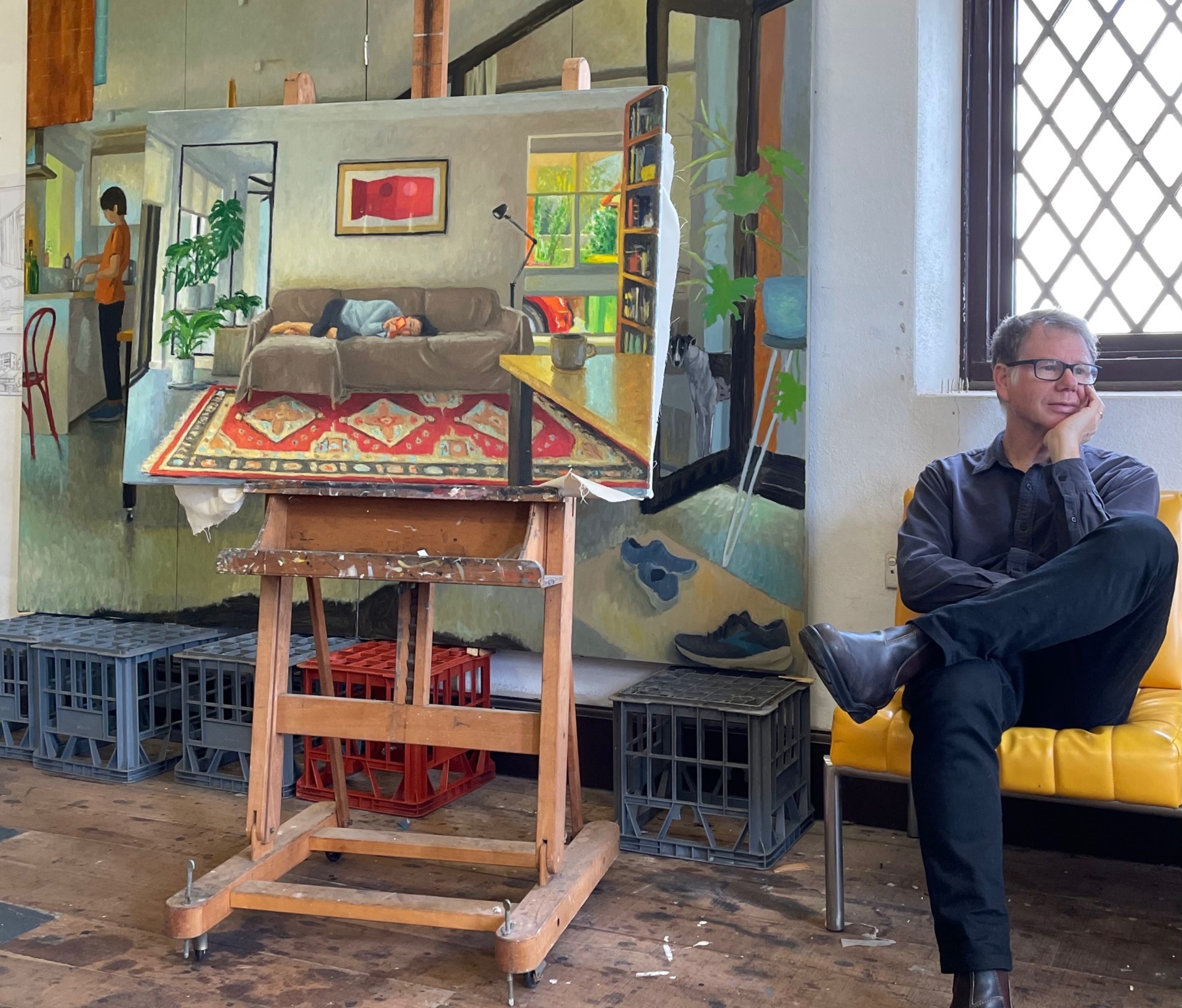
Richard Gunning in his studio at Fremantle Arts Centre
What gave the idea to start working with screens?
It’s partly drawn from a work I created about 25 years ago on a screen. I felt that this medium would marry well with the works Yoshiko is creating for the exhibition. A screen is somehow a little less intrusive than a painting. The space at Nyistor gallery is generous as well, so it lends itself to a larger work.
Richard, what attracts you to painting these domestic scenes which explore light and space?
I’m drawn to interiors simply because they are the space that we occupy. I anticipate doing landscapes as well and I have done landscapes, but part of the appeal of interiors is that you can control them a little easier. The same is the case with still life. So it’s kind of a progression on that. I work from life, as opposed to photographs. I never find photographs particularly appealing to work from as they are too static and don’t capture the full breadth of light and colour.
I understand this is the first time you have presented an exhibition together? What was it like working together?
Yoshiko: Yes, this is the first time. We’ve always created works separately and, even if we are working in the same space together, we try not to influence each other too much. But we thought it was about time we made something together, especially seeing we have this big space to work in together.
How does having a studio at Fremantle Arts Centre benefit your art practice?
Richard: One of the best things about having a studio here is that it’s not an outcome-based program, so you really have the freedom to experiment and develop your practice however you choose.
And the exhibitions program is fantastic, from the more contemporary exhibitions to the historical works in the Collection, it’s wonderful to have exposure to that while you are working, and that’s not always the case with studios.
Luminous Pursuit is at Nyisztor Studio from 30 October – 14 November
From 20 November, Fremantle Arts Centre presents Hundreds & Thousands: an immersive kids’ colour adventure, bringing the magic of colour to life with dazzling interactive artworks, highly sensory installations and educational experiences that invite curiosity, discovery and play.
Meandering through a spectrum of colour-themed spaces, audiences will encounter soft sculptures to touch, kaleidoscopic wall installations and twinkling fields of colourful lights—designed to spark little imaginations while expanding boundaries of perception and understanding.
Hundreds & Thousands brings together more than 20 artists of national and international renown including Sydney Ball, Brian McKay, Laurel Nannup, Ngamuru Bidu, Giles Hohnen, Tarryn Gill, Jeremy Kirwan-Ward, Rohin Kickett, Penny Coss, and Darren Siwes.
Among the exhibition are nine newly commissioned works by artists including Phil Gamblen, Rosie Deacon, Angela Ferolla, Sohan Ariel Hayes and Rachel Riggs, including surprising participatory works and unique colour stories that engage the senses in unexpected ways.
Bringing together works of magnificent scale and imagination, Hundreds & Thousands invites children to marvel at the joys of colour, to explore the intimate relationship between colour and emotion, and to reflect on the colourful moments in their own daily lives.
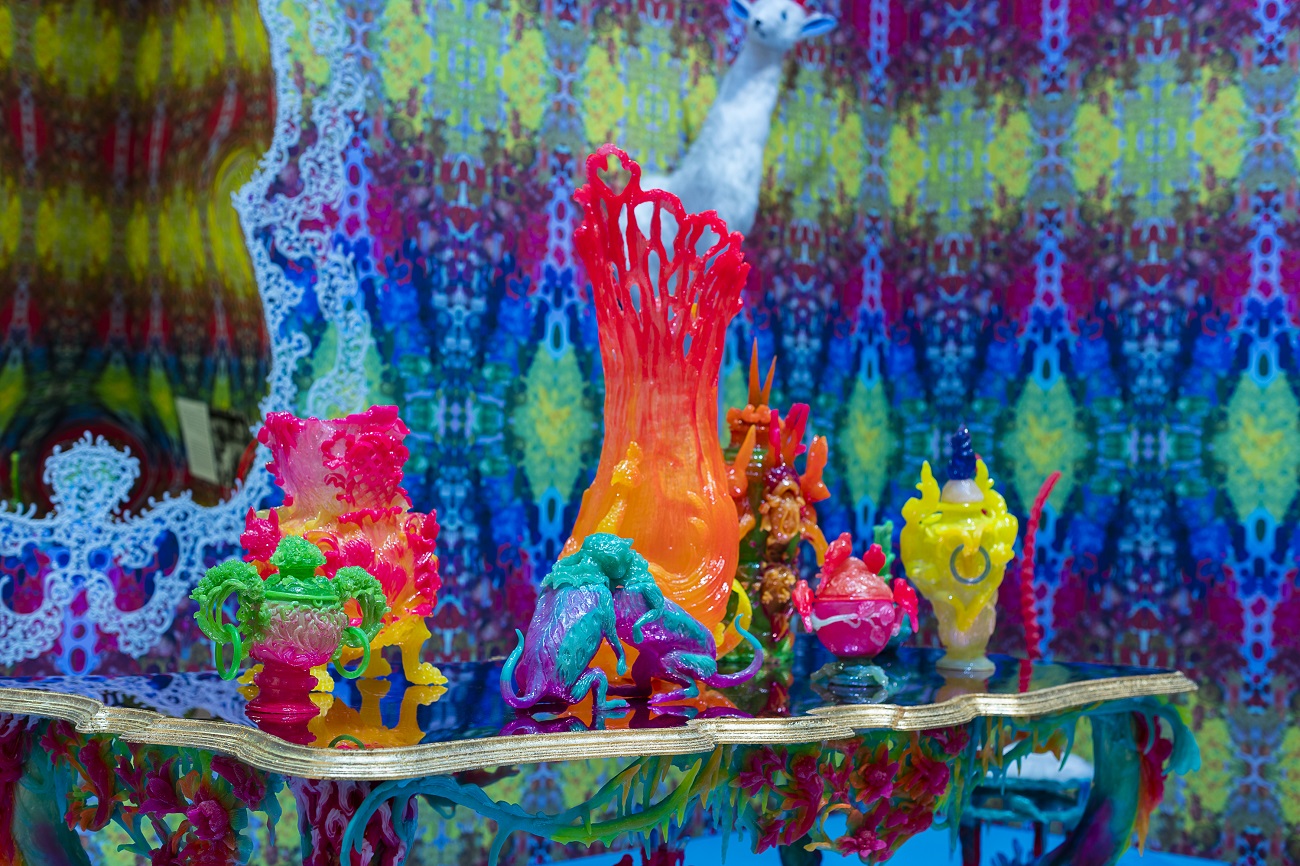
Kate Rohde, Ornament Crimes, 2015, mixed media, dimensions variable, exhibited at the National Gallery of Victoria
According to Glenn Iseger-Pilkington, Hundreds & Thousands co-curator, “The exhibition is a celebration of colour, an important aspect of visual language that many of us experience just months after entering the world. Hundreds & Thousands unites works from the City of Fremantle Collection and loans from private collections with recent commissions from leading Western Australian artists.”
Emma Buswell, who worked alongside Glenn as co-curator, commented, “Going to the Arts Centre as a kid was always a treasured time, walking through giant hallways, large than life galleries and grounds filled with flowers, birdsong and dappled light. It is exciting, decades on, to reimagine these spaces for a younger generation.”
Among the exhibition’s highlights, Perth-based artist Phil Gamblen will build an immersive installation of 3D-printed forms, each containing a programmed LED bulb. Upon first glance the forms appear white, but when the audience moves across them, they refract brilliant rays of colour that welcome movement and play.
Known for her intensely colourful sculptural objects, Melbourne-based artist Kate Rhode will create a large-scale kaleidoscopic wallpaper installation. Featuring dazzling neon patterns, this installation becomes an immersive point of entry to FAC’s galleries. The Ramsay Prize finalist will also exhibit a vivid series of whimsical cast-resin objects that speak to both real and imagined worlds.
Renowned puppet-maker Rachel Riggs will create a highly interactive work which encourages visitors to create stories using light and shadow, a tradition dating back in time. Meanwhile, Sydney-based artist Rox de Luca will present her extraordinary sculptural garlands of found-objects. The works, which feature hundreds of shards of plastic and debris collected from beaches in Bondi and Rose Bay, are a defiant commentary on the deluge of plastic waste that our species generates daily.
Local artists Catherine Taylor and Tyrown Waigana are working together to create a multitude of soft sculptures which audiences can touch and interact with. Created using recycled yellow fabric, these small minion-like creatures are an adaptation of one of Tyrown’s animations, made with the help of Catherine’s vast experience in costume design and textiles.
Taking place on 20 November, the Hundreds & Thousands exhibition opening will be a day-time affair for kids and families to enjoy, including family friendly entertainment, food, games and an array of interactive activities.
Following the opening event on Sunday 21 November, a specially curated edition of Sunday Music will brighten up the Front Garden, with Odette Mercy and her Soul Atomics’ Kids Soul Party offering up colourful tunes, dancing and kid-friendly fun.
A series of colourful public programs and special events will accompany Hundreds & Thousands, including pin-wheel flower making, community kite-flying days, special artist talks and education programs about the science and theory of colour.
Fremantle Arts Centre is also introducing a quiet hour to view the exhibition from 9-10am, available upon request. Groups and families wanting to experience Hundreds & Thousands in a more relaxed, unhurried environment can request access to the galleries for an hour before they open to the public. Enquiries can be emailed to [email protected].
Hundreds & Thousands runs from Sat 20 Nov till Sun 23 Jan, 10am – 5pm daily. Free entry. For more information, please visit fac.org.au
Media Contact: Rosamund Brennan, 08 9432 9565, [email protected]
Melbourne-based artist Shaun Wilson is Fremantle Arts Centre’s first ever Online Artist-In-Residence. The program was created as a response to creating art during the time of border restrictions and social distancing — providing virtual space for artists to explore and create digital art, to build online communities, and to have dedicated time and space for experimenting on something new.
An artist, film maker, academic and curator working with themes of memory, place and scale through painting, miniatures and video art, Shaun is using the online residency to develop a project called Revisiting the Decameron, part of a wider investigation ‘Winter Light’ examining the beauty and horror of plague through contemporary art.
‘Revisiting the Decameron’ deconstructs ‘The Decameron’, a series of novellas written by medieval author Giovanni Boccaccio around 1348. These stores digress seven young people sheltering in quarantine at an abandoned villa outside of Florence during the Black Death pandemic. The new works will situate the ten days of stories into a suite of ten works contextualising the backdrops of the Black Death and COVID-19.
Your online residency deconstructs ‘The Decameron’, a series of novellas written by medieval author Giovanni Boccaccio around 1348. How did you come across the Decameron text?
I’ve investigated the notion of place in my practice for almost two decades. In the midst of the COVID-19 pandemic, I felt compelled to explore how our connection to place had been ruptured, so I made a whole list of seminal books I wanted to get through which referenced plagues throughout history such as The Journal of the Plague Year by Daniel Defoe and Dante’s writings, and that research led me to a series of books that I’d never heard of before, including The Decameron.
What was it about The Decameron that resonated with you?
Well, the book is about ten wealthy young adults who flee Florence for the countryside during the Black Death. They hide in a villa outside of the city for two weeks and quarantine there, doing what normal young people would do in the middle of a disaster: entertaining themselves. There are stories of sex, romance and power. Reading this, you realise that perhaps we as humans perhaps haven’t changed all that much.
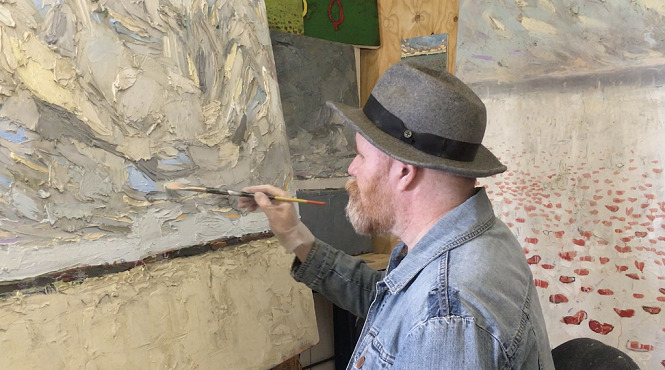
Online Artist-In-Residence Shaun Wilson working on his series Revisiting the Decameron
What I find really interesting about the text is that it is not unlike what is happening today. In Florence at the time of The Decameron, they shut the gates of the city and only the wealthy were allowed out, while the lower-class citizens bore the brunt of the disease entrapped in the walls of the city. I’m reminded of the social inequalities today of essential service workers where the low paid casualised workforce ploughed on through the pandemic while the lucky ones worked from home – like me – serviced by those who stayed in the front lines. Where is the social celebration of these people who supported the likes of me having the luxury of working from home? The Decameron makes this point loud and clear inasmuch as it does about the separation of places from which I normally would travel and move through.
The Black Death killed one in two people globally, but most of those people were those who were stranded in these gated communities. From this and others, there is a real class structure that has gone on throughout pandemics, and you see it even today in Victoria – with huge outbreaks happening in the city’s western and northern suburbs and these are often the places of industries which support the rest of us. It really makes me mad from a utilitarian point of view. The general populace is used as sponges to soak up pestilence and I wish there would be more attention on celebrating those in the front lines, from ICU wards to supermarket workers. They’re the unsung heroes who are always in the back of my mind when I paint these pictures of places from the book simply because the absence of those stranded in Black Death era Florence are also absent from the landscapes that I’m trying to capture as the silent characters in both the book and my paintings.
Why were you drawn to the online space as a place to explore these ideas as opposed to presenting a regular exhibition or a traditional residency?
I think doing an online residency during lockdown is really important because it’s the only way we can stay connected while isolated from one another. Also, I think it allows me to get in the right headspace to connect with the subject matter. We’ve all been living the last 18 months like the characters in the Decameron in some way or another.
I don’t think I could understand what that book meant until I knew what the characters were going through. It’s the best way to do it – conceptually and philosophically. It adds an honesty and an authenticity to making these paintings which on the surface may look like landscape paintings but conceptually, they’re loaded with the fact that I want to travel to places like those in the paintings but I can’t at the moment. So, it’s obvious that I’d make landscape the focus in lockdown, as we’re all dreaming of those landscapes that we can’t yet travel to. Place then becomes the central experience of lockdown secondary to health.
What have been some of the key challenges of the online residency?
I come from 20 years of cinematic art and video practice, but I didn’t want to resort to my usual bag of tricks in terms of how I was going to respond to this book, I just thought that’s too easy, I need something that’s hard. I’ve already had to teach myself and relearn everything I once employed about painting that I’d almost forgotten. It’s all flooded back rather quickly.
I haven’t explored 2D like I have this year, I’ve just gone bananas. The house looks like an art gallery! There’s been a lot of drafts and works in progress that haven’t even made it online. For every work you see I find it takes about three false starts before I get my visual language back together and into a rhythm again. The residency has mostly been about failure but at the same time, victory in small accidents.
What are you hoping the audience will take away from Revisiting the Decameron?
I guess there are two things, one of them being that I would like more artists to engage with innovative ways of making work and engaging with an audience during a lockdown. The pandemic has forced us to adapt our ways of working, and the visual arts is no exception. The online space offers so much flexibility and visibility which I hope more artists will take advantage of.
And secondly, I’d like the work to prompt people to think about how the pandemic is impacting not only themselves but at all levels of society through place. Who is being exploited or marginalised? Who is gaining an unfair advantage in this pandemic? What has changed between now and the Black Death? Every major pandemic has prompted a socialist revolution in some capacity about five or 10 years after the fact – we see this with the peasant revolt after the Black Death which then evolved through enlightenment to the early Modern period paving the way for the Renaissance; we see this in the 1665 plague of London with the burning of London and the reordering of enlightenment thinking through town planning in the restoration of London, we saw it in the rapid social transformations in the 1920s after the Spanish Flu propagating strengths of feminism and medical advances, and so forth. And we’ll see it happen after COVID-19 is over.
It’s an opportunity for us to reflect on the roles we play, individually and collectively to make our society, and from this, ourselves more intrinsic to the new world which we have the opportunity, warts and all, to rewrite. Again. But what I find is the most valuable and also the most painful of all is our relation to landscape and to our sense of place. Perhaps our experiences of the pandemic will allow us to reconsider place so invaluable that our lives need each other inasmuch as we need the connections to the places we dwell in, through our communities, through our lives, and of course, through the power and immediacy of art.
View Shaun Wilson: Revisiting the Decameron via studio.fac.org.au
